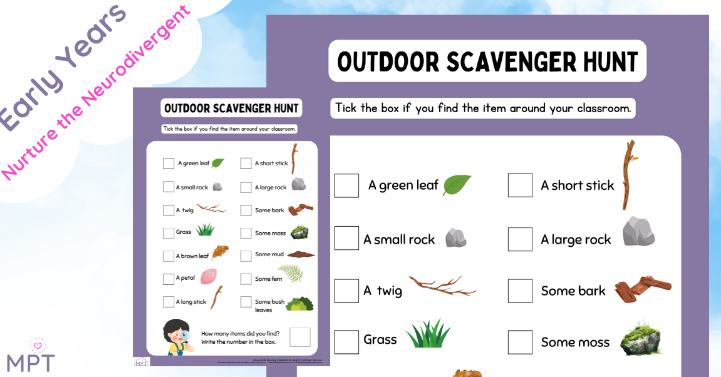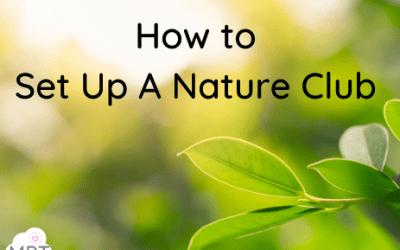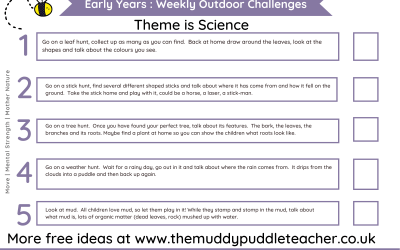Mud Kitchen: Dippy Dino Silly Soup Range ⇒Use the Mud Kitchen: Dippy Dino Soup from the Silly Soup range to help...
Mud Kitchen: Cracking Conker Silly Soup Recipe
Sep 10, 2021
Mud Kitchen: Cracking Conker Soup ⇒Use the Mud Kitchen: Cracking Conker Soup from the Silly Soup range to help...
Shade Slumbers (Wellbeing)
Sep 8, 2021
Wellbeing: Shade Slumbers ⇒Use the Shade Slumbers Activities to help children use the most simple gifts of nature to...
Petal Power (Wellbeing)
Sep 8, 2021
Wellbeing: Leaf Love ⇒Use the Petal Power to take you back to your own childhood and use the holistic joys of making...
Bug Spotter Template
Jun 9, 2021
Use this bug spotter sheet to get your class outside muddya nd messy! Supports the new EYFS curriculum.
Farm Park Resource (Footprint Spotter Sheet)
Apr 25, 2021
Going on a Farm Park Trip? Use Farm Park Resource (Footprint Spotter Sheet) to get your class outside, in the mud and...
Early Years Planting Calendar
Apr 19, 2021
Use the Early Years PLanting calendar to get a fun and organised planner to help you plant various plants if you are...
Set Up a Nature Club
Apr 19, 2021
Always wanted to set up an afterschool nature club? Well, this pack will help you! It gives you all the tips you need,...
Teddy Bears Picnic Ideas pack (Tots)
Apr 12, 2021
Use Teddy Bears Picnic Ideas pack for Tots to get this much-loved song and story outside the Muddy Puddles Way! EYFS...
DIY Baby Toys Activity Pack
Apr 7, 2021
Use DIY Baby Toys Activity Pack to help you come up with free toys that you can make from unused items around you...
*FREE*Early Years Weekly Outdoor Challenges (Science KUW Theme)
Jan 24, 2021
Early Years Weekly Outdoor Challenges (Science KUW Theme) 5 daily ideas
*FREE*Butterfly Spotter Activity Sheet
Jan 22, 2021
Use the Butterfly Spotter Activity Sheet to get the children outside applying their Science and knowledge in an active...
Autumn Colour Spotter Sheet Activity
Jan 22, 2021
Use the Autumn Colour Spotter Activity Sheet to get the children outside applying their maths while they connect with...
Summer Colour Spotter Activity Sheet
Jan 22, 2021
Use the Summer Colour Spotter Activity Sheet to get the children outside applying their maths while they connect with...
Spring Spotter Activity Sheet
Jan 22, 2021
Use the Spring Spotter Activity Sheet to get the children outside applying their maths while they connect with nature...
Winter Colours Art Activity Sheet
Jan 21, 2021
Use the fabulous Winter Colours Art Activity Sheet to get the children outside applying their maths while they connect...
Winter Colour Spotter Activity Sheet
Jan 21, 2021
Use the mud-tastic Winter Colour Spotter Sheet to get the children outside applying their maths while tey connect with...
Muddy Babies Easter
Jan 6, 2021
Muddy Babies Easter In a nutshell: How will I receive the resource? Once you have proceeded to checkout it will be...
New In

Feelings Reflection Sheet

Daily Journal SEND

One-Page Profiles for SEND

Forest School Scavenger Hunt

Outdoor Learning Colour I Spy

Outdoor Learning Colour Wheel

Outdoor Learning Colour Scavenger Hunt

Outdoor Learning Scavenger Hunt (Toddlers)

Outdoor Learning Scavenger Hunt




















